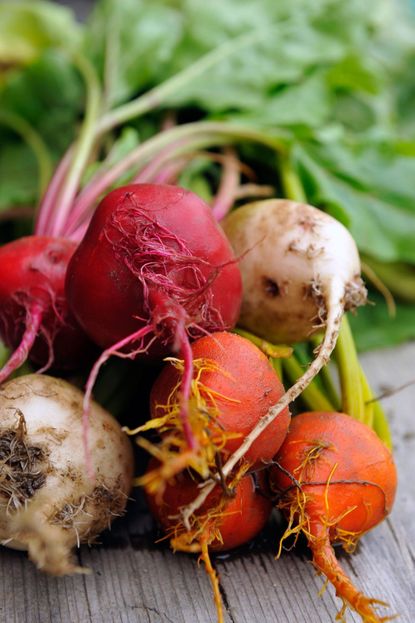Types Of Beet Plants: Learn About Different Beet Varieties


If you live in a cool climate, cultivating beets is the perfect garden project for you. Not only are they tolerant of cooler temperatures, but these little beauties are almost completely edible; the greens are excellent in salads and the roots can be steamed, roasted, or pickled. There are many different beet varieties, so it's just a matter of deciding which types of beet plants you would like to grow.
How to Grow Different Beet Types
The table beet is also referred to as the garden beet, blood turnip, or red beet. Beet tops are extremely high in Vitamin A, while the beet root is a good source of Vitamin C. These cool weather veggies are fairly easy to grow. Most types of beet plants are tolerant of heat, but truly thrive in temps between 60 and 65 degrees F. (15-18 C.) in full sun and can withstand chilly temps shy of freezing. They can be planted 30 days before the frost free date of your region. Grow beets in loose, well-draining soil that has been raked free of stones and other debris that can affect development of the root. If you have heavily clay laden soil, amend it with organic matter. Be sure that your soil has a pH of between 6.2 and 6.8 since beets are sensitive to acidity. Plant beet seeds ½ inch (1 cm.) deep, spaced one inch (2.5 cm.) apart with 12 to 18 inches (31-46 cm.) between rows. Thin the seedlings to 1 to 3 inches (1-8 cm.) apart.
Common Varieties of Beet
As mentioned, there are a number of different varieties of beet, each with its unique properties. Most are grown for the beet root itself, which comes in a variety of shapes, sizes, and hues, although some types, such as ‘Bull's Blood,' are grown primarily for the greens. Some varieties of beet are grown for their ability to be stored for long periods of time. There are a number of open pollinated beets available to the home gardener. Crosby's Egyptian is another excellent varietal grown for not only its uniform, sweet red root, but for its tender tasty greens as well. Some of the earliest maturing heirloom varieties include:
- Detroit Dark Red (matures in 58 days)
- Early wonder (52 days)
- Sangria (56 days)
- Sweetheart (58 days)
Ruby Queen matures in 60 days and is very tender, sweet with uniform roots, while Lutz Green Leaf is ready in 70 days and is purplish red with large tasty green tops and is grown as a winter-keeper type of beet. Some of the hybrid varieties of beet include:
- Avenger, which is good for green and globe-shaped red roots
- Big Red matures in 55 days and is one of the best late season producers.
- Gladiator is rapidly maturing at only 48 days and is great for canning.
- Pacemaker is ready at 50 days with excellent roots.
- Red Ace matures in 53 days with sweet roots and vigorous growth.
- Warrior takes 57 days and has uniform, globe-shaped roots that develop rapidly and greens tinged with red.
There are also miniature varieties of beets such as Little Ball (50 days) and Little Mini Ball (54 days), whose roots only get to the size of a silver dollar and, thus, are extremely tender. There are also some specialty beet varieties grown for specific characteristics.
- Cylindria (60 days) is grown for its long, cylindrical shape which results in slice of equal size.
- Touchstone Gold is a new variety with small yellow roots that retain their color once cooked.
- Green Top Bunching (65 days) has bright red roots with superior tops for greens
- Golden (55 days) has a lovely buttery yellow color and a sweet, mild flavor
- Di Chioggia (50 days) is an Italian heirloom known for its striped red and white interior, sweet, mild taste and early maturation.
Whichever type of beet variety you decide to grow, most beets can be stored for several weeks, either in a bag in the refrigerator, in a root cellar, or outdoor pit dug into the ground prior to freezing. Beets store best at 32 degrees F. (0 C.) with 95 percent humidity.
Gardening tips, videos, info and more delivered right to your inbox!
Sign up for the Gardening Know How newsletter today and receive a free download of our most popular eBook "How to Grow Delicious Tomatoes."

Amy Grant has been gardening for 30 years and writing for 15. A professional chef and caterer, Amy's area of expertise is culinary gardening.
-
 Grow a Bathroom Oasis: 8 Best Bathroom Plants With No Light or Low Light
Grow a Bathroom Oasis: 8 Best Bathroom Plants With No Light or Low LightSome apartment dwellers grow the best bathroom plants with no light or low light. Read how one of our favorite plant lovers does it in the big city.
By Teo Spengler
-
 "My Worst Mistake" – Gardeners Share 10 Hard-Learned Lessons
"My Worst Mistake" – Gardeners Share 10 Hard-Learned LessonsGardeners never stop learning, and sometimes our mistakes are the best teachers. But why not save time and heartache by learning from other gardeners' failures?
By Melanie Griffiths